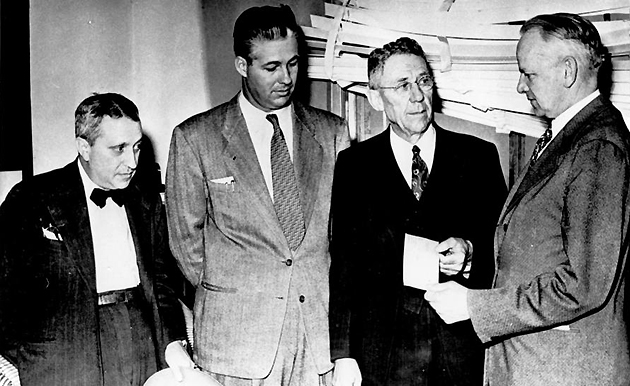Ships in Texas City Port
Source: Houston Chronicle, circa June 2018
Source: Houston Chronicle, circa June 2018
"The Disaster left an indelible mark on the city, but the people of Texas City proved resilient."1
Political Impact
Clark Thompson, a U.S. Representative of Galveston would push Congress to give reparations to the residents of Texas City, so that they could repair their town and their lives. In 1955 the bill was passed, enabling seventeen million dollars to be dispersed to 1,400 residents. This would allow the people of Texas City to rebuild.
Social Impact
After the 1947 explosions, officials realized that there would have to be a new approach to combat a disaster. Numerous people agreed that having a plan in place before a disaster occurred would have been beneficial. As a result of this, refineries in the region built the Industrial Mutual Aid System (IMAS). This new system would help any city or town in the area, in the event of a disaster. Many of the local companies would join the system, which would benefit everybody involved.
Source: Texas DPS Museum
"Because of such incidents and subsequent studies of the properties of AN (ammonium nitatre), caked AN is no longer broken up with explosive materials, and organic materials, such as paraffin wax, are no longer used to coat AN prills."3
Economic Impact
Monsanto, which sustained the worst damage, was the first refinery to pledge to rebuild in Texas City. Other companies quickly followed Monsanto's lead with pledges of their own, and the residents of Texas City gradually rebuilt their town. At the time of the 2010 Census, it was home to about 45,000 people, and the city continues to grow. Even today, the petrochemical industry is still a major factor in the city's economy.
"Here in Texas City we have approximately nineteen plants. We have Marathon, Valero, Eastman—say Marathon has three firetrucks, Eastman has one, Texas City Fire Department has four, so what they do is we pull all our mutual aid together, industrial mutual aid to help fight that fire."
-Thomas Munoz, Current Texas City Emergency Manager4
-Thomas Munoz, Current Texas City Emergency Manager4
Footnotes:
1. Stuart, Daniel, et al. “1947 Texas City Disaster Online Exhibit.” Moore Memorial Public Library, Moore Memorial Public Library, www.texascity-library.org/page/history.1947.home.
2. Ibid.
3. United States, Congress, EPA, et al. “Chemical Advisory - Solid Ammonium Nitrate (AN) Storage, Handling and Management.” Chemical Advisory - Solid Ammonium Nitrate (AN) Storage, Handling and Management, Environmental Protection Agency, June 2015.
4. Munoz, Thomas. “Interview with Thomas Munoz.” Telephone Interview. 27 Nov. 2018.
1. Stuart, Daniel, et al. “1947 Texas City Disaster Online Exhibit.” Moore Memorial Public Library, Moore Memorial Public Library, www.texascity-library.org/page/history.1947.home.
2. Ibid.
3. United States, Congress, EPA, et al. “Chemical Advisory - Solid Ammonium Nitrate (AN) Storage, Handling and Management.” Chemical Advisory - Solid Ammonium Nitrate (AN) Storage, Handling and Management, Environmental Protection Agency, June 2015.
4. Munoz, Thomas. “Interview with Thomas Munoz.” Telephone Interview. 27 Nov. 2018.
|
John Castaneda, Nicolas Gonzales, Soraida Sosa, Isaac Veloz
Senior Group Website Website Student Generated Words: 1152 Process Paper Student Generated Words: 484 Media Duration: 3:45 |
Best viewed at resolutions
of 1280 x 1024 or greater on Google Chrome |
